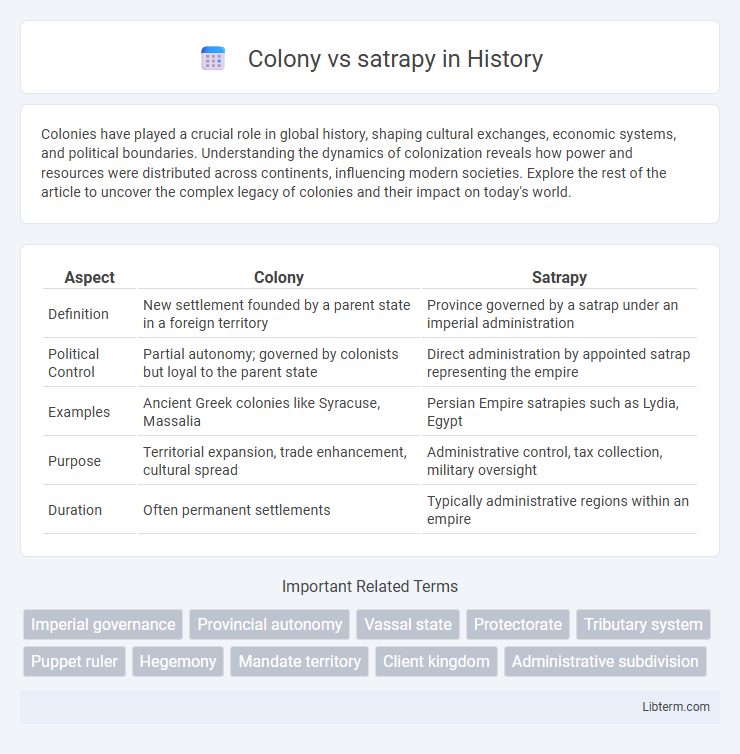Colonies have played a crucial role in global history, shaping cultural exchanges, economic systems, and political boundaries. Understanding the dynamics of colonization reveals how power and resources were distributed across continents, influencing modern societies. Explore the rest of the article to uncover the complex legacy of colonies and their impact on today's world.
Table of Comparison
| Aspect | Colony | Satrapy |
|---|---|---|
| Definition | New settlement founded by a parent state in a foreign territory | Province governed by a satrap under an imperial administration |
| Political Control | Partial autonomy; governed by colonists but loyal to the parent state | Direct administration by appointed satrap representing the empire |
| Examples | Ancient Greek colonies like Syracuse, Massalia | Persian Empire satrapies such as Lydia, Egypt |
| Purpose | Territorial expansion, trade enhancement, cultural spread | Administrative control, tax collection, military oversight |
| Duration | Often permanent settlements | Typically administrative regions within an empire |
Defining Colony and Satrapy
A colony is a territory settled and governed by a foreign power that often establishes new communities with economic and strategic interests, while a satrapy is an administrative division within an empire overseen by a satrap, or governor, appointed by the central authority to collect taxes and maintain order. Colonies typically involve the transplantation of settlers and cultural influence, whereas satrapies maintain local structures under imperial control. The Achaemenid Empire exemplifies the satrapy system, contrasted with Greek colonial expansion in the Mediterranean.
Historical Origins of Colonies and Satrapies
Colonies historically originated as settlements established by ancient civilizations, such as the Greeks and Phoenicians, to expand trade routes and cultural influence across distant territories. Satrapies were administrative divisions in the Achaemenid Persian Empire, designed to maintain centralized control by appointing satraps or governors to oversee local governance and tribute collection. The core distinction lies in colonies being autonomous outposts for expansion, while satrapies functioned as bureaucratic regions under imperial oversight.
Governance Structures Compared
Colonies were typically governed by officials appointed directly from the colonizing country, establishing centralized control often through a governor or colonial administration. Satrapies, as administrative regions of empires like the Persian Empire, were managed by satraps who had considerable autonomy but remained accountable to the central monarch. The governance structure of a satrapy balanced local customs with imperial oversight, whereas colonies often imposed the colonizer's legal systems and policies more rigidly.
Administrative Autonomy: Colony vs Satrapy
A colony typically enjoys limited administrative autonomy, operating under the direct control of its founding nation's government, often with appointed officials managing local affairs. In contrast, a satrapy, historically seen in empires like the Achaemenid Empire, maintains a higher degree of autonomy by allowing local rulers or satraps to govern regional administration while remaining loyal to the central authority. This distinction highlights colonies as extensions of the imperial power's bureaucracy, whereas satrapies blend imperial oversight with localized governance structures.
Economic Roles and Resource Management
Colonies often functioned as economic outposts designed to extract resources, establish trade routes, and cultivate new agricultural products beneficial to the mother country's economy. Satrapies, governed by satraps in the Persian Empire, played a crucial role in regional resource management by collecting taxes, overseeing local production, and ensuring the flow of goods like metals, grains, and crafts to the imperial center. While colonies emphasized economic expansion and direct resource exploitation, satrapies balanced tribute extraction with administrative control to maintain imperial stability and economic integration.
Relationship with the Central Power
A colony functions as an extension of the central power with direct administrative control, often ruled by officials appointed from the central authority, ensuring strict governance and resource extraction. In contrast, a satrapy maintains a degree of local autonomy under the oversight of a satrap or governor who acts as a regional proxy, balancing local interests with loyalty to the central power. The relationship in a colony is more centralized and interventionist, whereas a satrapy operates through delegated authority, preserving local structures while securing allegiance to the empire.
Cultural Integration and Influence
Colonies often experienced significant cultural integration through the settlement of people from the colonizing power, leading to a blending of customs, languages, and traditions that reshaped local identities. Satrapies, governed as administrative regions within empires like the Persian Empire, maintained more of their indigenous cultures while adopting imperial practices primarily for governance and taxation. The key difference lies in colonies fostering cultural hybridization and demographic changes, whereas satrapies emphasized administrative control with limited cultural assimilation.
Military Organization and Defense
A colony typically maintained a local militia supplemented by settlers to defend against external threats, often relying on the home city-state for naval support and strategic direction. In contrast, a satrapy, governed by an appointed satrap under an empire like the Persian Empire, featured a formalized military garrison overseen by imperial troops to ensure centralized control and rapid defense against rebellions. The military organization in satrapies was more hierarchical with standardized imperial forces, whereas colonies depended more heavily on citizen-soldiers integrated within the local community structure.
Examples from World History
Colonies such as the British establishments in North America and Australia functioned as politically dependent territories with varying degrees of self-governance, established primarily for economic benefit and settlement. Satrapies, exemplified by the Persian Empire under Darius I, operated as administrative provinces governed by satraps who enforced imperial control and collected taxes while allowing local customs to persist. The key distinction lies in colonies being external settlements established by a mother country, whereas satrapies were integral parts of a vast empire managed through appointed governors.
Legacy and Impact on Modern Systems
Colonies laid the foundation for modern nation-states by spreading culture, language, and legal systems, influencing contemporary concepts of sovereignty and governance. Satrapies contributed to administrative frameworks through centralized control and regional governance, inspiring aspects of federalism and bureaucratic organization in modern governments. The legacy of colonies and satrapies is evident in global political boundaries, legal traditions, and administrative structures used in present-day statecraft.
Colony Infographic

 libterm.com
libterm.com